
HEAD MOVEMENTS VIBRAIMAGE VISUALIZATION AND ENERGETIC MODEL OF EMOTIONS
Viktor A. Minkin, Georgi P. Gladyshev and Libb Thims
ABSTRACT
Greatest past scientists (Aristotle, Charles Darwin, Konrad Lorenz) declared the indissoluble link between motions and live, or biological objects state.
Vibraimage technology registers space distribution of object vibration parameters, like frequency and amplitude in every pixel [1]. It was determined, that vibraimage parameters are indicated psycho physiological human state [2]. From the other side are well known psychodynamics and human thermodynamics theories based on classic physics and thermodynamics laws for explanation of human's emotions and behavior [3].
INTRODUCTION
Head movements in space classically associated with vestibular system are studied and discussed in relation to the status of vestibular reflexes (i.e., the vestibuloocular, vestibulocollic, and cervicoocular reflexes) [4,5,6]. This article is the attempt to look on head movements according to the first and second thermodynamics laws with application of vibraimage system and technology. We supposed that head balance for person without consciously movements could be considered as isolated thermodynamic system and any internal energy as emotion would change the balance of this internal system and realized by movements or vibrations. Every emotion state characterized by specific energy conversation and work done on the system transfers on micro vibrations, if the person forced to stand or seet still. The head vibtration parameters (frequency in range 0,1-10 Hz and amplitude) are stable in time for stable emotion condition of person. Parameters of vibrations changed after emotion alteration. VibraImage technolgy allows to contactless register of person vibration parameters and calculates emotions according to accomulated statistics of comparitive testing with EEG, skin galvanic reaction and psychological testing. VibraImage technics, parameters and research results are below:
METHODS
VibraImage equipment
It is possible to use standard video system for vibraimage registration, like web cam or digital camera, or analogue camera with digitizer. The camera resolution was 640×480 and vibraimage quality highly depends on camera noise. The best results were achieved with easy AVerCam, web cam with 1/3 inc image CMOS sensor.
The computer was also standard NB Samsung P40 TV001 with PentiumM2000 processor and VibraImage 6.1 software from Elsys Corp. The camera stands about 0,5 m near the tested person and head was large visible on the monitor.
VibraImage parameters
Amplitude and frequency of human head vibrations differs in every point of space and total processing of this every point meaning could present integral movement parameter of person. Some vibraimage pictures of one person reflects amplitude (Fig. 1) and frequency (Fig. 2) space distribution of vibrations are showed below visualized by color scale (Fig. 3):
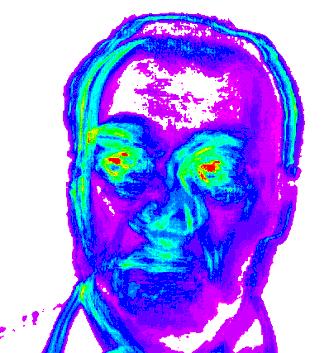 |
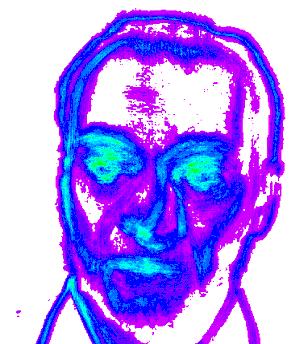 |
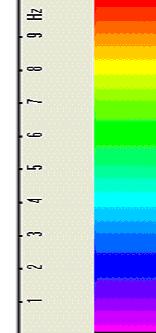 |
| Fig. 1 | Fig. 2 | Fig. 3 |
Based on this two primary images are calculated about 20 integral vibraimage parameters reflects different types of movement and vibration divided into 4 main groups:
| A- amplitude parameters |
| B- frequency parameters |
| S- symmetry parameter |
| P- space and time processing parameters |
Detail description of this parameters written in VibraImage help file (download)
RESULTS
Aura-Vibraimage
Line distribution of maximum frequency and medium amplitude looks like aura and informatively shows human state. The aura color-coded frequency by the same color scale (Fig. 3) and aura size coded amplitude. Any irregularity in aura colors and size characterized object movements and psychophysiological state. Samples aura person in normal conditions and stress are on Fig. 4 and Fig. 5
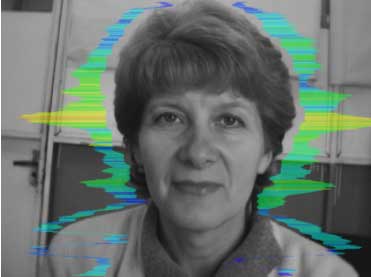 |
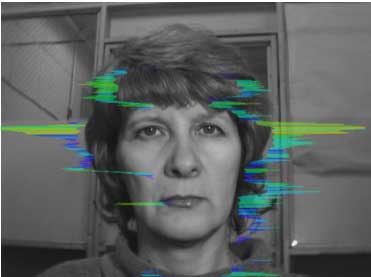 |
| Fig. 4 | Fig. 5 |
Frequency histogram
Frequency histogram shows head frequency distribution for every pixel and for accumulated time period (default time period is equal 20 seconds). Some real samples histograms coordinated with emotions and energy levels are printed in this point.
Figure 6 shows distribution histogram for person in normal conditions, both graphics approximately looks like normal (Gaussian) distribution. On Fig. 7 we see un normal human states, up graphic shows person with low energy level (very tired) and down graphic shows high energy emotions (anger).
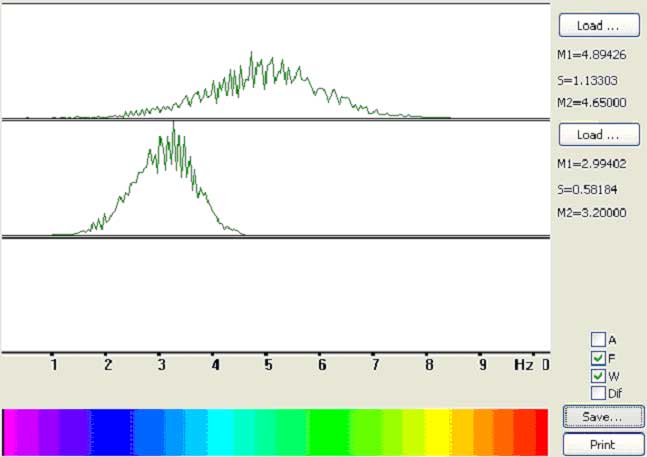 |
| Fig. 6 |
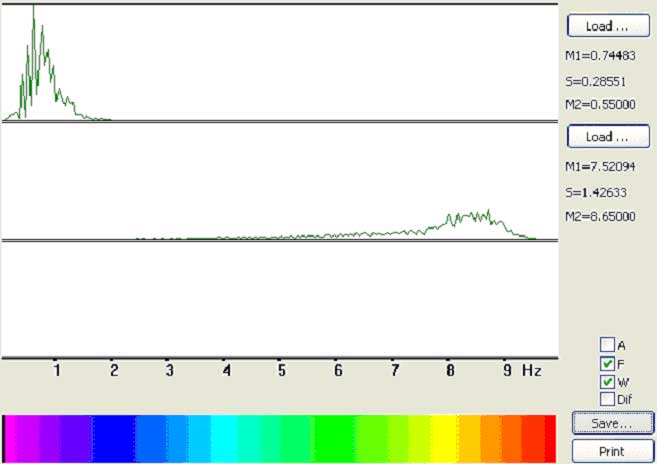 |
| Fig. 7 |
Spectral analysis
Spectral analysis of time dependence high speed vibraimage signals, also could informative reflects person emotions. Person in normal conditions have several time more low frequency square in vibration spectrum, than person in tension or aggression. On Figure 8 we see the sample of normal state person on up graphic and tension person spectrum on the down graphic.
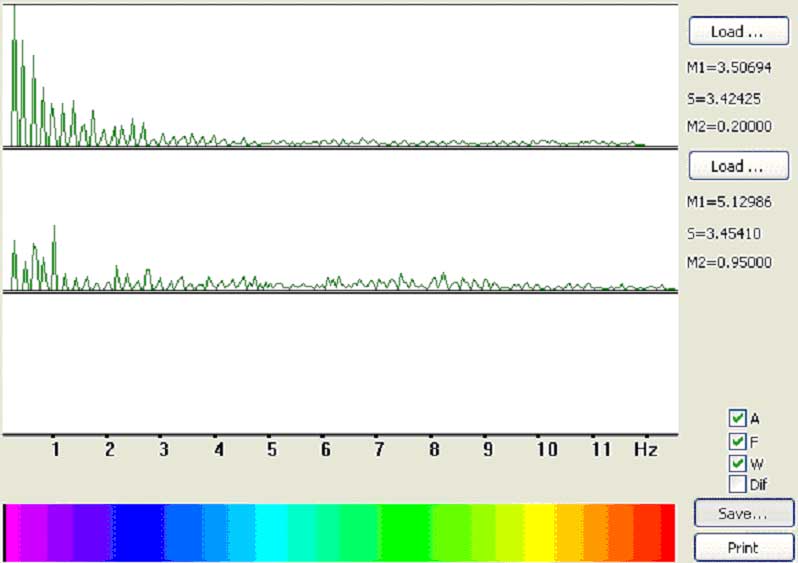 |
| Fig. 8 |
EEG and VibraImage testing
EEG is well known and informative psychophysiological testing, of course we adjusted and tested vibraimage system by comparative EEG testing. VibraImage signals recorded analogical EEG signals by developed VibraEEG system. Program menu with recorded information cite on Fig. 9
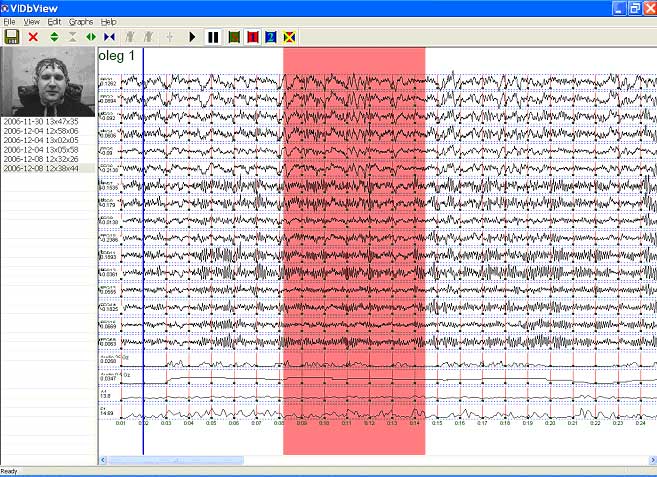 |
| Fig. 9 |
Was calculated correlation between EEG signals and VibraImage signals in theta frequency range (4-8) Hz for person in still conditions (Fig. 10) and aggressive conditions (Fig. 11).
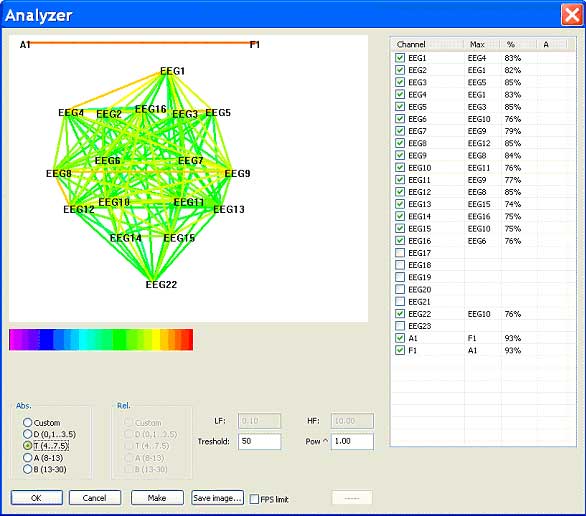 |
| Fig. 10 |
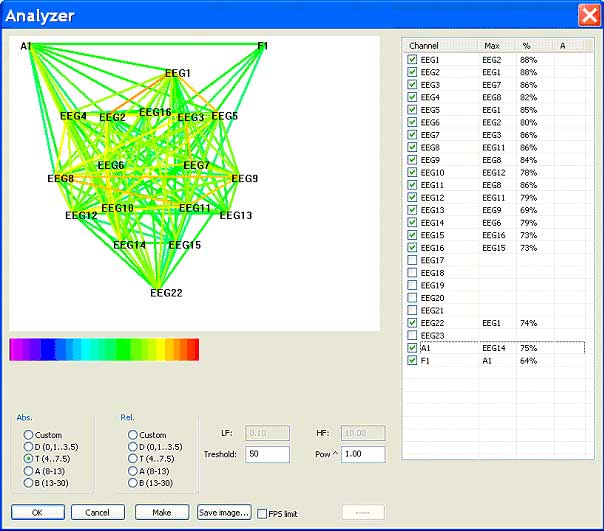 |
| Fig. 11 |
It is clear visible, that VibraImage parameters has strong correlation with EEG parameters for aggressive state and have not any correlation with EEG when person is still. That means that head motion depends on minds when person have high internal energy level, and head motion does not depend on mind activity when person is still, low energy and have not strong minds.
DISCUSSIONS
Emotion processing
First law of thermodynamics regulates the conservation of energy The change in the internal energy of a closed thermodynamic system is equal to the sum of the amount of heat energy supplied to the system and the work done on the system.
The mathematical statement of the first law is given by
dU = δQ — δW,
where dU is the infinitesimal increase in the internal energy of the system, δQ is the infinitesimal amount of heat added to the system, and δW is the infinitesimal amount of work done by the system on the surroundings. The infinitesimal heat and work are denoted by δ rather than d because, in mathematical terms, they are inexact differentials rather than exact differentials. According to the Hierarchical thermodynamics of Gladushev [7] it is possible to consider the person in the mechanical balance at the same time in the biochemical balance and dW is the infinitesimal amount of work done by the system in microvibrations. The human?s termoregulation supports the body themprature stable, so the emotional energy must be proportional to head movements and microvibrations.
Psychology differs more that 200 emotions, that means the different time and space energy distribution, because every emotion characterized by own behavior and energy. In general it is possible to suggest the following formala reflect energy

Ei — i- emotion (aggression, stress, tension e.t.c.);
 | — is the time infinitesimal amount of work done by the system in the form of microvibrations; |
 | is the spacial infinitesimal amount of work done by the system in the form of microvibrations |
CONCLUSIONS
- Opportunity of remote and contactless emotion detection is science proved.
- Vibraimage technology registers microvibration and could be applied for emotion calculation.
- Human thermodynamics has experimental confirmation.
REFERENCES
- Pub. No: US 2004/0131275 Method and device for image transformation, Viktor Minkin, Alexander Shtam, Date Jul. 8, 2004
- RU 2289310 Method for psychophysiological information obtained from biological objects. Viktor Minkin, Alexander Shtam, prior date 16 Feb. 2004
- Libb Thims, Human Thermodynamics, VI IoHT Publications, Ltd. 2002 (1st Ed.)
- Signal Processing in the Vestibular System During Active Versus Passive Head Movements, Kathleen E. Cullen and Jefferson E. Roy Aerospace Medical Research Unit, Department of Physiology, McGill University, Montreal, Quebec H3G 1Y6, Canada Submitted 14 October 2003; accepted in final form 9 January 2004
- Effects of Unilateral Vestibular Deafferentation on the Linear Vestibulo-Ocular Reflex Evoked by Impulsive Eccentric Roll Rotation S. T. Aw, M. J. Todd, L. A. McGarvie, A. A. Migliaccio, and G. M. Halmagyi, Neurology Department, Royal Prince Alfred Hospital, Sydney NSW 2050, Australia, J Neurophysiol (February 1, 2003). 10.1152/jn.00819.2002
- The Journal of Neurophysiology Vol. 79 No. 4 April 1998, pp. 2025-2039 Copyright ©1998 by the American Physiological Society Off-Centric Rotation Axes in Natural Head Movements: Implications for Vestibular Reafference and Kinematic Redundancy W. P. Medendorp1, B.J.M. Melis2, C.C.A.M. Gielen1, and J.A.M. Van Gisbergen1 1 Department of Medical Physics and Biophysics, University of Nijmegen, NL 6525 EZ Nijmegen; and 2 Visio, Regionale Instelling Noord, NL 9752 AC Haren, The Netherlands
- Georgi Gladyshev Hierarchical thermodynamics — general theory of existence and living world development, Report dedicated to 70th Birthday of Professor Gladyshev, 19 Sept. 2006, Alma-Ata (Kazakhstan, were he was born), National Technical University and National University of Kazakhstan (in Russian, Abstract in English) http://www.endeav.org/evolut/age/evol.htm

© 2001-2008 ELSYS Corp.

